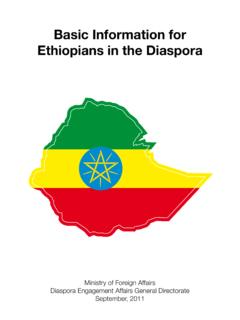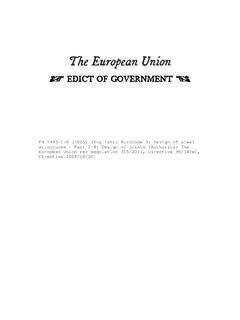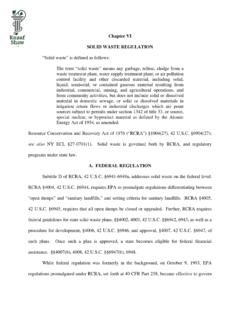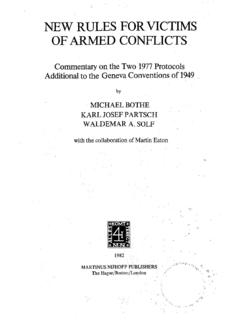Transcription of A Guide to the Convention on Wetlands (Ramsar, …
1 The ramsar Convention ManualA Guide to the Convention on Wetlands ( ramsar , Iran, 1971)3rd editionRamsar Convention Secretariat 2004 The ramsar Convention Manual, 3rdedition2 The ramsar Convention Manual: a Guide to the Convention on Wetlands ( ramsar , Iran, 1971), 3rd ed. Gland, Switzerland: ramsar Convention Secretariat, ramsar Convention Secretariat 2004 Reproduction of material from this publication for educational and other non-commercial purposes is authorized withoutprior permission from the ramsar Secretariat, providing full acknowledgment is given. Reproduction of material for resaleor other commercial purposes is prohibited without the prior written permission of the ramsar : The designation of geographical entities in this Manual, and the presentation of the material, do not imply theexpression of any opinion whatsoever on the part of the ramsar Convention Secretariat concerning the legal status of anycountry, territory, or area, or of its authorities, or concerning the delimitation of its frontiers or : ramsar Convention Secretariat, 2004.
2 The ramsar Convention Manual: a Guide to the Convention on Wetlands ( ramsar , Iran, 1971), 3rd ed. ramsar Convention Secretariat, Gland, Switzerland. 2 February World Wetlands DayJoin the worldwide ramsar community in commemorating the anniversary of the Convention . 3A Guide to the Convention on Wetlands , ( ramsar , Iran, 1971)Foreword to the 3rdedition51. The ramsar is the ramsar Convention on Wetlands ? are Wetlands ? conserve Wetlands ? an intergovernmental Convention on Wetlands ? do nations join the ramsar Convention ? may join the ramsar Convention ? are the commitments of Parties joining the ramsar Convention ? interpretation of the The ramsar Convention The ramsar Strategic Plan and the three pillars of the Synergies with other environment-related conventions142. A brief history of the ramsar Convention Paris Protocol and the Regina ramsar chronology key reading223.
3 How does the ramsar Convention work? Conference of the Contracting Standing Administrative Authorities and diplomatic Scientific and Technical Review ramsar Convention ramsar ramsar with other organizations294. Assisting the Contracting Criteria for identifying Wetlands of International The Information Sheet on ramsar The ramsar Sites Classification System for wetland The Montreux The ramsar Advisory Article wise use of Establishment of national wetland Knowledge of Wetlands and their Action at particular wetland The Wise Use and Training43 Table of ContentsThe ramsar Convention Manual, Cooperation with and between Contracting Transboundary wetland Transboundary species conservation The twinning of ramsar Regional cooperation: the MedWet Small projects assistance programmes.
4 SGF and Project support and external support the ramsar The Convention s CEPA ramsar and the World Wetlands Day and WWD The wetland Conservation The Wise Use Resource The ramsar Signs at ramsar Sites535. How States may join the ramsar The instrument of accession Designating Wetlands for the ramsar The cost of joining the Convention55 Appendices561 Text of the ramsar Convention562 Resolutions and Recommendations of the Conference of the Contracting Parties613 References674 The ramsar Toolkit : contents of the Handbooks series705 Glossary of ramsar acronyms, abbreviations, and terminology71 Glossary72-755A Guide to the Convention on Wetlands , ( ramsar , Iran, 1971)When the ramsar Manualwas first compiled by T. J. Davis and published in 1994, it was enthusiastically welcomedas an essential vade mecumthrough the sometimes bewildering world of ramsar resolutions, guidelines, andterminology.
5 It grew out of date quickly, however, especially because the work completed by the Conference of theContracting Parties at its 6thmeeting, held in Brisbane in 1996, added a large number of new tools to the Convention , a second edition was published in 1997, incorporating all of the institutional changes of the preceding threeyears and including as annexes all of the major documents associated with the COP7 in San Jos in 1999, however, it was felt that the volume of ramsar documentary material had simply growntoo large to be included as appendices to the Manual, and that the growing use by the public of the ramsar Web site hadmade the descriptive body of the Manualless necessary. At that time, then, the ramsar Manual was let go out of print, andthe 9-volume ramsar Toolkit (The ramsar Handbooks for the Wise Use of Wetlands ) was published separately in January 2000in order to make available all of the major guidance adopted by the Handbooks have proved to be invaluable, and a second edition, including the guidance documents emerging fromCOP8 in Valencia in 2002, will be available on CD-ROM in early 2004.
6 The judgment about the explanatory body of theManual, however, turned out to be wrong, and many people have argued that there is still a need for a brief, printedintroduction to the Convention and its processes. Thus this third edition contains a thorough update of the second, taking account of all that has changed since 1997. In placeof the 2ndedition s 17 documentary appendices, however, in this edition we have substituted merely a list of references to theWeb addresses of all of the documents mentioned in the text and a list of the contents of the forthcoming 14-volumeHandbooks series. For ramsar documents and resources mentioned that the text without references, those links can befound in Appendix for additions and improvements to this Manual in an eventual fourth edition will be very : Parts of the following text have been cross-referenced to other sections of the text by use of the symbol to indicatesection 2004 Foreword to the 3rdEnglish editionThe ramsar Convention Manual, What is the ramsar Convention on Wetlands ?
7 The Convention on Wetlandsis an intergovernmental treaty adopted on 2 February 1971 in the Iranian city of ramsar , onthe southern shore of the Caspian Sea. Thus, though nowadays the name of the Convention is usually written Conventionon Wetlands ( ramsar , Iran, 1971) , it has come to be known popularly as the ramsar Convention . ramsar is the first ofthe modern global intergovernmental treaties on the conservation and sustainable use of natural resources, but, comparedwith more recent ones, its provisions are relatively straightforward and general. Over the years, the Conference of theContracting Parties has further developed and interpreted the basic tenets of the treaty text and succeeded in keeping thework of the Convention abreast of changing world perceptions, priorities, and trends in environmental official name of the treaty, The Convention on Wetlands of International Importance especially as Waterfowl Habitat, reflectsthe original emphasis upon the conservation and wise use of Wetlands primarily as habitat for waterbirds.
8 Over the years,however, the Convention has broadened its scope to cover all aspectsof wetland conservation and wise use, recognizingwetlands as ecosystems that are extremely important for biodiversity conservation and for the well-being of humancommunities. For this reason, the increasingly common use of the short form of the treaty s title, the Convention onWetlands , is entirely appropriate. (Changing the name of the treaty requires amending the treaty itself, a cumbersomeprocess that for the time being the Contracting Parties are not willing to undertake.)The Convention entered into force in 1975 and now (as of February 2004) has 138 Contracting Parties, or member States,in all parts of the world. Though the central ramsar message is the need for the sustainable use of all Wetlands , the flagship of the Convention is the List of Wetlands of International Importance(the ramsar List ) presently, the Parties havedesignated for this List more than 1,370 Wetlands for special protection as ramsar Sites , covering 120 million hectares( million square kilometres), larger than the surface area of France, Germany, and Switzerland United Nations Educational, Scientific and Cultural Organization (UNESCO) serves as Depositary1for the Convention ,but the ramsar Convention is not part of the United Nations and UNESCO system of environment conventions andagreements.
9 The Convention is responsible only to its Conference of the Contracting Parties (COP), and its day-to-dayadministration has been entrusted to a secretariat under the authority of a Standing Committee elected by the COP. TheRamsar Secretariat is hosted by IUCN The World Conservation Union in Gland, mission of the ramsar Convention , as adopted by the Parties in 1999 and refined in 2002, is the conservation and wiseuse of all Wetlands through local, regional and national actions and international cooperation, as a contribution towardsachieving sustainable development throughout the world . What are Wetlands ? Wetlands are areas where water is the primary factor controlling the environment and the associated plant and animal occur where the water table is at or near the surface of the land, or where the land is covered by shallow water.
10 The ramsar Convention takes a broad approach in determining the Wetlands which come under its aegis. Under the text ofthe Convention (Article ), Wetlands are defined as: areas of marsh, fen, peatland or water, whether natural or artificial, permanent or temporary, with water that is static or flowing, fresh, brackish or salt, including areas of marine water the depth of which at low tide does not exceed six metres .In addition, for the purpose of protecting coherent sites, the Article provides that Wetlands to be included in the RamsarList of internationally important Wetlands :1. The ramsar Convention1 The Depositary receives, reviews, and accepts the instruments of accession of each county member of the treaty, keeps the official text of the Convention in six officiallanguages, and provides legal interpretations of the text when required. The Depositary does not have a role in the administration and/or implementation of the Guide to the Convention on Wetlands , ( ramsar , Iran, 1971) may incorporate riparian and coastal zones adjacent to the Wetlands , and islands or bodies of marine water deeper than six metres at low tide lying within the Wetlands .





